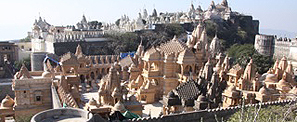Jain Architectural Heritage
Building New and Restoring Old Temples in Gujarat, India
A film by Niels Gutschow and Rabindra Vasavada
D, 2011, 39 minutes
Jainism is an ascetic religion of India. It teaches the immortality and transmigra-tion of the soul and denies the existence of a supreme being. Beside some three million followers in India there is a substantial community in Europe as well as North America. The avoidance of harm and violence (in Sanskrit ahimsa) is its highest precept. For lay people, monks and nuns, pilgrimage represents an exercise of overwhelming significance. Pilgrims visit the birthplaces of the 24 saints, the Tirthankaras, and sacred moun-tains, Shatrunjaya being the most important one among them.
Almost seven hundred metres high, the Shatrunjaya mountain at Palitana attracts many pilgrims because seeing the mountain alone ensures merit. The two ridges at the top are covered by 863 temples. These are painstakingly maintained by the Shri Anandji Kalyanji Trust.
Since centuries a coat of plaster is regularly scraped off from the porous Drangadhra stone with which the temples were built. Joints are grouted and the surface is covered again by a thin coat of plaster. Authentic is the unseen bearing structure with the rough outline of the sculptural décor. Equally authentic is also the practice of the cyclic renewal of the surface with its delicate details. The aim is to present the abodes of the saints in an im-maculate, ever new form.
The documentation features on-site discussions from 18 to 20 November 2009 at the Nandishvara Dvipa at Umafai Tuk, at the workshop of the sculptor, Arvindbhai Ishwarlal Sompura at Palitana, the temple architect Virendra K. Trivedi in Ahmedabad and Nimesh Shah, production manager at Trivedi Marbles.
As examples of new temples the Vardamantirtha at Varman is visited and the Suguna Vihardham at Rojit. On these, marble is used to impart an appearance of permanence and freshness.

